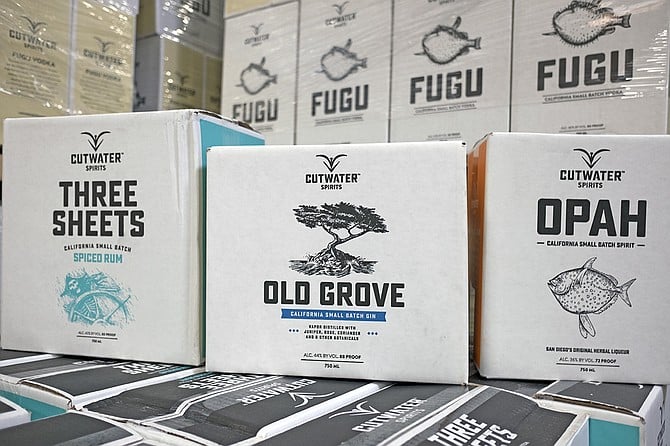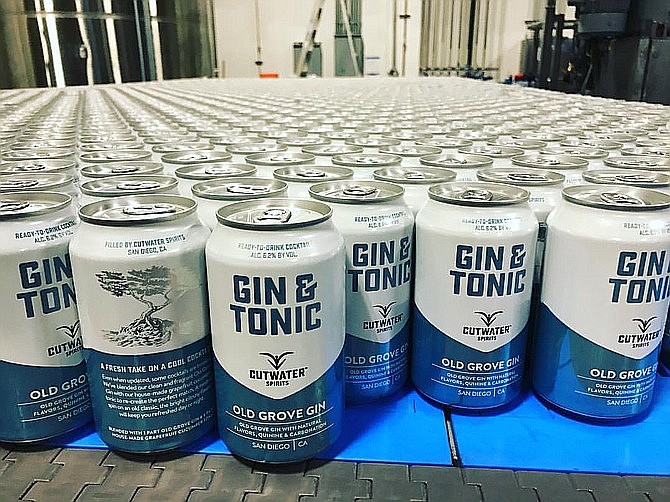 Facebook
Facebook
 X
X
 Instagram
Instagram
 TikTok
TikTok
 Youtube
Youtube

When Ballast Point Brewing & Spirits sold to Constellation Brands in fall 2015, a small part of the business wasn't included: the spirits. For the moment, Ballast Point no longer produces liquor. Instead, a new brand has emerged to continue the work of Ballast's distilling side: Cutwater Spirits.
"The spirits company was actually always separate from Ballast," points out marketing manager Nicole Ganz, one of a handful of executives who left the brewing company to join the Cutwater team.
"We're still the same company," confirms Earl Kight, another Ballast alum who serves as Cutwater's chief revenue officer. "We still have the same license, all we did was a name change."
Jim Buechler, who stepped down as president and CEO of Ballast last July, has assumed the same role at Cutwater. Meanwhile, head brewer Yuseff Cherney is now head distiller of the spirits company he cofounded with Jack White, who initially established Ballast Point two decades ago.

Kight notes the spirits side of that business dates back to 2008. "The distillery was kind of a hobby, to tell you the truth. It was not even secondary. Our secondary business was our mixers." That includes a fast-selling bloody mary mix, which is also now sold under the Cutwater brand, along with a canned line of premixed cocktails and bottles of the former Ballast spirit lines, including Fugu vodka, Old Grove gin, Three Sheets rums, and Devil's Share whiskeys.
Thus far, Cutwater has begun local and limited out-of-state distribution of these products, which were made under the Ballast Point shingle. In fact, most of the roughly 800 liquor barrels stored in Cutwater's new Miramar production facility are still branded with the Ballast logo and have been aging for years.
However, a lot is about to change, in a huge way. This 50,000-square-foot property — mere blocks from Ballast's vast Miramar brewery and restaurant — will feature a 220-seat restaurant of its own, plus 30,000 square feet devoted to production and packaging the product of eight stills.
"We used to make rum, whiskey, everything out of this one still," says Cherney, noting that the new facility may average 30 barrels of liquor a day, whereas Ballast's Scripps Ranch distillery peaked out at 8 a month. "In three months," he adds, "we'll have more than we've made in our entire lifespan at Ballast Point."
The building’s centerpiece is a 40-foot column, continuous still, named for its ability to produce liquor around the clock. Perhaps as awe-inspiring is a collection of four 200-barrel oak foeders, where whiskey and bourbon mash will undergo open fermentation prior to distilling.
"It's basically the way they do it in Kentucky," Cherney says. While Cutwater won't have the inventory to release large quantities of whiskey until it’s aged a minimum four years, the foeders will be visible through windows in the restaurant's dining room and open for tours. "The people that are touring will be able to get up there and stick their finger in it," he adds, "taste it, and see the mash fermentation going on."
The Cutwater team can't say for sure, but speculates this may soon wind up being the largest distillery on the West Coast. "Hopefully," concludes Cherney. "That's kind of what we're shooting for."
No timetable has been given for the opening of the Cutwater restaurant.


When Ballast Point Brewing & Spirits sold to Constellation Brands in fall 2015, a small part of the business wasn't included: the spirits. For the moment, Ballast Point no longer produces liquor. Instead, a new brand has emerged to continue the work of Ballast's distilling side: Cutwater Spirits.
"The spirits company was actually always separate from Ballast," points out marketing manager Nicole Ganz, one of a handful of executives who left the brewing company to join the Cutwater team.
"We're still the same company," confirms Earl Kight, another Ballast alum who serves as Cutwater's chief revenue officer. "We still have the same license, all we did was a name change."
Jim Buechler, who stepped down as president and CEO of Ballast last July, has assumed the same role at Cutwater. Meanwhile, head brewer Yuseff Cherney is now head distiller of the spirits company he cofounded with Jack White, who initially established Ballast Point two decades ago.

Kight notes the spirits side of that business dates back to 2008. "The distillery was kind of a hobby, to tell you the truth. It was not even secondary. Our secondary business was our mixers." That includes a fast-selling bloody mary mix, which is also now sold under the Cutwater brand, along with a canned line of premixed cocktails and bottles of the former Ballast spirit lines, including Fugu vodka, Old Grove gin, Three Sheets rums, and Devil's Share whiskeys.
Thus far, Cutwater has begun local and limited out-of-state distribution of these products, which were made under the Ballast Point shingle. In fact, most of the roughly 800 liquor barrels stored in Cutwater's new Miramar production facility are still branded with the Ballast logo and have been aging for years.
However, a lot is about to change, in a huge way. This 50,000-square-foot property — mere blocks from Ballast's vast Miramar brewery and restaurant — will feature a 220-seat restaurant of its own, plus 30,000 square feet devoted to production and packaging the product of eight stills.
"We used to make rum, whiskey, everything out of this one still," says Cherney, noting that the new facility may average 30 barrels of liquor a day, whereas Ballast's Scripps Ranch distillery peaked out at 8 a month. "In three months," he adds, "we'll have more than we've made in our entire lifespan at Ballast Point."
The building’s centerpiece is a 40-foot column, continuous still, named for its ability to produce liquor around the clock. Perhaps as awe-inspiring is a collection of four 200-barrel oak foeders, where whiskey and bourbon mash will undergo open fermentation prior to distilling.
"It's basically the way they do it in Kentucky," Cherney says. While Cutwater won't have the inventory to release large quantities of whiskey until it’s aged a minimum four years, the foeders will be visible through windows in the restaurant's dining room and open for tours. "The people that are touring will be able to get up there and stick their finger in it," he adds, "taste it, and see the mash fermentation going on."
The Cutwater team can't say for sure, but speculates this may soon wind up being the largest distillery on the West Coast. "Hopefully," concludes Cherney. "That's kind of what we're shooting for."
No timetable has been given for the opening of the Cutwater restaurant.
Comments